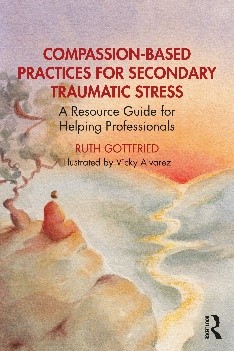
With deep appreciation, I wish to express my gratitude to Stanford University’s Center for Compassion and Altruism Research and Education (CCARE) for its unwavering commitment to cultivating a more compassionate world and for the profound impact it has had on the lives of countless individuals, myself included. My training with CCARE was pivotal in shaping my Capstone Project into a compassionate resource guide that has recently been published by Routledge. As an Ambassador of Applied Compassion through CCARE, I am deeply committed to compassionately addressing secondary traumatic stress and promoting wellbeing.
I first learned about secondary traumatic stress as a dance movement therapist and have experienced its effects firsthand. Today, I am grateful that my personal journey, combined with my academic research on trauma, secondary traumatic stress, and compassion, has led me to a position where I have been able to create a relevant resource guide for organizational leaders and professionals in trauma-related fields. I often reflect on how valuable a resource guide like this would have been for me, and my hope is that both organizational leaders and professionals will find it insightful and beneficial in their important work.
 Through my Capstone Project at CCARE, I developed Compassion-Based Practices for Secondary Traumatic Stress. This comprehensive resource guide merges state-of-the-art theoretical insights with practical, compassion-centered practices, highlighting the essential principle of caring for caregivers. Tailored for organizational leaders and helping professionals from diverse fields of practice working with survivors of trauma, it offers a compassionate framework for addressing secondary traumatic stress—recognized as traumatic stress originating from indirect trauma exposure.
Through my Capstone Project at CCARE, I developed Compassion-Based Practices for Secondary Traumatic Stress. This comprehensive resource guide merges state-of-the-art theoretical insights with practical, compassion-centered practices, highlighting the essential principle of caring for caregivers. Tailored for organizational leaders and helping professionals from diverse fields of practice working with survivors of trauma, it offers a compassionate framework for addressing secondary traumatic stress—recognized as traumatic stress originating from indirect trauma exposure.
Compassion-Based Practices for Secondary Traumatic Stress is distinguished by its in-depth, research-supported, and hands-on approach, inclusion of East-Asian philosophical principles, and harmonization of self- and other-oriented compassion. Following the extensive literature review, a wide selection of individual and group contemplative and creative arts-based practices is presented. Moreover, beautiful hand-drawn watercolor illustrations and haiku poetry are interwoven throughout, providing both aesthetic enrichment and contemplative pauses.
Importantly, the resource guide incorporates an invitational approach and inclusive, trauma-informed language, aiming to establish a safe and welcoming environment for learning, reflection, and engagement. It serves as both a starting point and an ongoing resource that organizational leaders and helping professionals can revisit and tailor according to their needs, preferences, and circumstances. The guide is valuable not only for those currently experiencing secondary traumatic stress but also for those seeking to proactively replenish the compassion they extend to both themselves and others as a protective measure.
Thank you again to CCARE’s leadership and participants for creating such a unique learning environment, where I had the opportunity to explore the intersection of compassion and secondary traumatic stress through a profound writing journey. Compassion-Based Practices for Secondary Traumatic Stress represents the culmination of my ongoing efforts and has even inspired me to enhance my knowledge further. Since graduating from the training at CCARE, I have embarked on a second PhD at Tel Aviv University’s Department of East-Asian Studies where I am focusing on compassion and secondary traumatic stress from a Buddhist perspective, based on Śāntideva’s Bodhicaryāvatāra.
May whatever merits gained by the creation of this resource guide be dedicated to all those who have experienced trauma, to the compassionate caregivers caring for them, and to a more compassionate world for us all.
